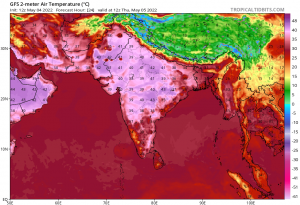Heatwave Sweeps Through India, More than a Billion People Experience Deadly Heat

Intense heat has been felt across a large portion of Southern Asia over the last two weeks, with more than a billion people experiencing temperatures of 40°C (104°F) mostly in India and Pakistan. Other areas in the subcontinent recorded temperatures close to 50°C (122°F.) Residents say it feels like summer came too early as some experienced power outages. The Indian Government reportedly mulled the decision to ban the export of wheat in the country, as the heat dries up crops across the country.

In the city of Nawabshah, in the Pakistani province of Sindh, the Pakistan Meteorological Department recorded a temperature as high as 49.5°C (121°F) on Sunday. Other cities in Sindh Province also saw the mercury rise to 49°C (120°F) in Jacobabad; 48.5°C (119°F) in Mohenjo Daro; and 48°C in Larkana, Sakrand and Padidan. In Punjab Province, Rahim Yar Khan recorded a temperature of 47.5°C (118°F;) and Balawalpur recorded 47°C (117°C. The same temperature was recorded in Sibbi, in Balochistan Province. Meanwhile in India, the Indian Meteorological Department reported that 10 cities recorded temperatures of at least 45°C (113°F.) Indian authorities in the state of Maharashtra now reported 25 deaths since March related to extreme heat.
The heat also affected India’s capacity to produce wheat. Gurvinder Singh, director of agriculture in Punjab, said that an average increase of up to 7°C (13°F) in April had reduced wheat yields in the state. “Because of the heatwave we’ve had a loss of more than 500 kilograms per hectare of our April yield.” Wheat farmers, who have to be under the sun for most of the day to do manual labor, were left with fewer options to combat the heat. With reduced production, Indian authorities are now discussing restricting exports. It comes after five straight years of record harvest in the world’s eighth-largest producer of wheat in the last harvest season. Some wheat farmers are now uncertain about how much the next farming season between October and December would be affected as the world’s climate continues to warm.
Another casualty of the heatwave was the Indian power grid, with some areas having power outages for more than 14 hours. The intense heat caused by the recent heatwave drives demands to increase, requiring power plants across the country to produce more electricity. Added to the problem is that 70% of India’s electricity was produced by coal power plants, which are also experiencing supply problems. In order to reduce strain on the power plants, many passenger trains halted operations in order to reduce consumption and to clear more tracks to cargo trains delivering coal to the power plants. Authorities say there is no other short-term way to solve the electricity problem.
A representative of the United Nations International Panel on Climate Change that the world would continue to experience such events like this in increasing frequency and severity, and that the only way to mitigate the effects of climate change is to abide to the 2015 Paris Climate Agreement that sets the global goal of limiting the global warming to 1.5°C higher than pre-industrial levels. The Force Thirteen Web Team will publish a section in the website about Climate Change in the early part of July. Other informational articles will also be published in the website.
